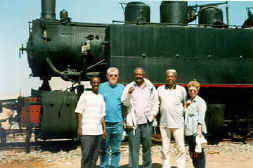
Bringing rail travel back to Eritrea has been a huge undertaking. Train service had been halted during Eritrea's 30-year struggle for independence from Ethiopia, and everything from rail cars to rail lines had been commandeered by both sides in their war effort.
Independence was finally achieved in 1991, and rebuilding Eritrea has included rebuilding the railroad.
'By invitation
only'
Eritrea's Chief Statistician, Tecklemichael
Giorghis, is the former Minister of Transportation and has retained
responsibility for rebuilding the railroad.
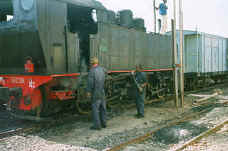 A
few weeks before the rail line was to be opened to the public, Dr. Giorghis
kindly invited Rick and me to join him on the 70-km train ride from Ghinda
— a town some 50 km from Asmara, where we live — to the coastal city of
Massawa on the Red Sea.
A
few weeks before the rail line was to be opened to the public, Dr. Giorghis
kindly invited Rick and me to join him on the 70-km train ride from Ghinda
— a town some 50 km from Asmara, where we live — to the coastal city of
Massawa on the Red Sea.
At that time the rail reconstruction had reached no farther inland than Ghinda, which represents 70 km of the total 120 km route between Massawa and Eritrea's capital city of Asmara. These 70 km represent a climb of 1,200 meters or half of the total 2,400-meters height that will be climbed and descended when the rail line is complete.
Since the rail line didn't yet extend to Asmara, we were up early on Saturday, January 30, to drive down the mountain to Ghinda, where the steam engine and our adventure awaited.
It was the trip of a lifetime for Rick and me! The smells and sounds of the rails made us feel like we were stepping back in time….
Some different
kinds of hazards!
Along with Dr. Giorghis and the Ghinda
station manager, we boarded an open car with an overhead canopy of canvas
to protect us from the sun.
Ahead of us was the steam engine, followed
by three boxcars filled with excited Eritreans, their baggage and packages,
their grains, and their goats and chickens
.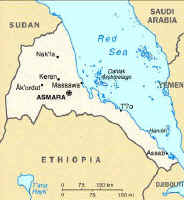 Dr.
Giorghis explained that safety is of prime concern because Eritreans are
no longer used to having a working railway line. They often walk along
the tracks with their herds of camels, cattle and goats. As well, the rail
line and the road are separated by only centimeters at one point along
the route!
Dr.
Giorghis explained that safety is of prime concern because Eritreans are
no longer used to having a working railway line. They often walk along
the tracks with their herds of camels, cattle and goats. As well, the rail
line and the road are separated by only centimeters at one point along
the route!
So, a brakeman rides on each car and receives instructions from the engineer through coded train whistles. As you can imagine, co-ordination is paramount as the train winds its way down the mountain.
The ear-piercing train whistle is also frequently sounded to warn away herds of animals.
A reminder
from long ago
The train's top speed will be 40 kph
once it's fully tested, but we didn't exceed 25 kph during our outing.
The more leisurely pace was perfect: seated on wooden benches and enjoying
refreshments, we had ample time to take in the scenery along the way.
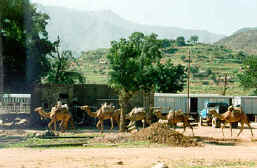 We
also enjoyed the running commentary and tales of Dr. Giorghis, who'd served
as a freedom fighter in the war of independence and who described many
points of interest along our route.
We
also enjoyed the running commentary and tales of Dr. Giorghis, who'd served
as a freedom fighter in the war of independence and who described many
points of interest along our route.
Many young Eritreans have never seen a train before, and the excitement was evident on their smiling faces as they frantically waved … as if at a piece of history that was thundering by.
Many of the older people we passed remembered the glory of the train years gone by, and they were clearly very proud.
A glimpse
of what's ahead
We stopped at several stations to
let passengers disembark and come aboard.
The main stations at Ghinda and Mai
Atel — which means 'the goat watering place' — still retain the fading
beauty of their Italian architecture. We imagined how lovely and gracious
they had been 30 years ago … and soon will be again.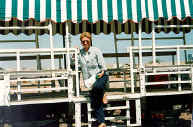 All
along the line, cash-crop fruit and vegetable farming is being re-established
because regular rail operations will mean an efficient way to transport
produce to the markets in Asmara.
All
along the line, cash-crop fruit and vegetable farming is being re-established
because regular rail operations will mean an efficient way to transport
produce to the markets in Asmara.
As we reached the end of our journey at the coastal city of Massawa, our faces were blackened from soot, steam and smoke, mostly from having passed through long, dark tunnels in which you literally couldn't see your hand in front of your face.
We were saddened to see our adventure end. But at the same time we were energized by the sheer magnitude of the work and ingenuity behind the laying of those 70 km of railroad tracks!

Home |

Scrapbook |
| Who | What | Why | When | Where |